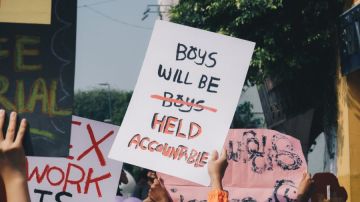1 in 16 Women Were Raped During First Sexual Intercourse Experience
Sexual violence against women is more prevalent than many might think and a new study reveals that the first sexual experience for more than 3 million women in the U

Photo: Unsplash/@michelleding
Sexual violence against women is more prevalent than many might think and a new study reveals that the first sexual experience for more than 3 million women in the U.S., many in their teens, was forced or coerced.
“Any sexual encounter (with penetration) that occurs against somebody’s will is rape. If somebody is verbally pressured into having sex, it’s just as much rape,” lead author Dr. Laura Hawks, an internist and Harvard Medical School researcher said to USA Today.
The study, published in the medical journal JAMA Internal Medicine, surveyed more than 13k women between the ages of 18 to 44. For those who willingly chose to have sex, about 56 percent described being verbally pressured, 46 percent said they were held down, and 25 percent said they were physically harmed.
Of the 6.5 percent of respondents who said their first experience was rape said it happened around the age of 15 and the men were six years older. Seven percent said they were younger than 10 at the time of the assault, while 29 percent said they were between the ages of 11 and 14. The largest segment, at 39 percent, said the assaults happened between the ages of 15 and 17.
The effects of this trauma are long term with the study revealing increased rates of HIV, sexually transmitted diseases, pelvic inflammatory disease, endometriosis, and menstrual problems. Additionally, 30 percent of women reported an unwanted first-time pregnancy, compared to 18 percent of women who said they chose to have sex the first time.
According to the Office of Victims of Crimes, based on the U.S. Census, projections for the Latina population and that one in six women 13 or older are victims of rape or sexual assault, the number of Latinas who have experienced some form of sexual violence could reach 10.8 million by 2050.
In a 2009 report released by the Southern Poverty Law Center 77 percent of the Latinas surveyed
said that sexual harassment was a major problem in the workplace. “Our culture teaches people not to be raped instead of teaching people not to rape,” sex education specialist Dan Rice said about the state of sex education in schools to USA Today. Though women of all racial and socioeconomic backgrounds reported these assaults, women of color and women in poverty reported higher rates of first-time forced sex, PBS reports.
“A practicing physician is likely to see several patients each week who have experienced this form of trauma,” the authors wrote in the study, suggesting doctors develop tools to identify and aid these patients. With Latinas, in particular, it’s important to train doctors to be aware of cultural influences and to develop a safe space for Latinas and Latina immigrants to be able to discuss assault.
In 2017, Los Angeles Police Chief Charlie Beck said reports of sexual assault and domestic violence decreased in the Latinx community and he attributed it to immigration status keeping women from coming forward.
“Imagine, a young woman, imagine your daughter, your sister, your mother … not reporting a sexual assault, because they are afraid that their family will be torn apart,” Beck said, reports the Los Angeles Times.
Though his statements are speculative, there’s no doubt that the current political climate might deter immigrants from speaking up but this study is also indicative of the importance of the #MeToo movement in giving women a voice and platform against sexual violence.

















